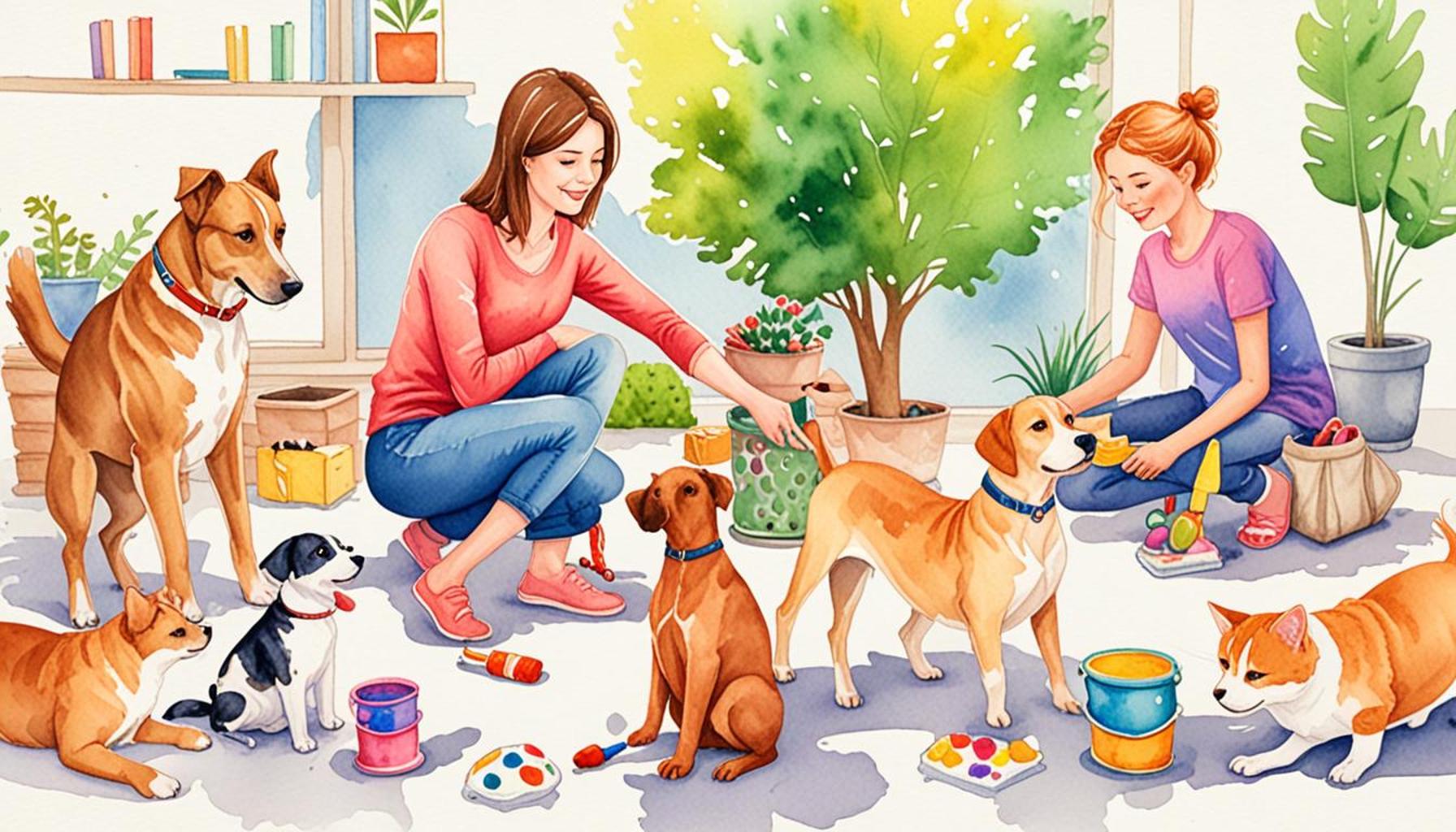The Role of Training in the Socialization of Pets: Building Pleasant Behavior

The Critical Role of Pet Training in Socialization
Training your pet goes beyond simply teaching them how to sit or stay; it serves as a fundamental component in ensuring their effective socialization. By engaging in training, pet owners lay the groundwork for their animals to thrive both at home and in various community settings.
A well-trained pet often contributes to a more harmonious household. With clear behavioral expectations established, interactions between pets and their human companions become smoother. This can lead to less frustration for pet owners and fewer misunderstandings between pets and children or guests. As a result, it nurtures a peaceful living environment that benefits everyone involved.
Here are some key benefits of training in the socialization of pets:
- Encourages Positive Behavior: Training assists in instilling good manners, helping pets learn to walk on a leash without pulling, greet guests politely, or refrain from excessive barking. For instance, teaching a dog the command “leave it” can prevent them from grabbing potentially dangerous items off the ground.
- Improves Safety: Properly trained pets tend to respond promptly to their owners’ commands and cues, which can be crucial in emergencies. A dog that understands recall commands can quickly return when called, reducing the risk of accidents in potentially hazardous situations.
- Strengthens Bonds: Engaging in training sessions provides an opportunity for pets and owners to interact in a structured environment. This creates a dynamic of trust and respect, enhancing their emotional connection. Positive reinforcement methods, such as treats and praise, can make training enjoyable for both parties, resulting in a stronger bond.
Moreover, research indicates that well-socialized pets are more adaptable in diverse environments. For example, dogs exposed to different people, noises, and other animals during their formative months are less likely to exhibit anxiety or aggression later on. This is particularly important in the United States, where pets frequently accompany their owners in public places, from parks to cafes. Early exposure leads to more confident pets.
By focusing on training early in a pet’s life, owners can avoid many issues that may arise during their animal’s adolescent phase. Behavioral problems such as separation anxiety or destructive chewing can often be mitigated through proper socialization techniques. This foundational training not only paves the way for a happy pet but also contributes to a long-lasting, rewarding relationship between the pet and its owner.
Techniques and Strategies for Effective Training
This article will delve deeper into various evidence-based training techniques and their influence on socialization, as well as practical strategies that will empower your pet to thrive. Techniques such as positive reinforcement, clicker training, and socialization exercises can all contribute significantly to a pet’s development.
Understanding these training methods and their role in fostering social skills will enable pet owners to develop happy, well-adjusted companions. In turn, these companions can enhance the quality of life for both themselves and their human families, leading to a more fulfilling coexistence.
Understanding Effective Training Methods for Pet Socialization
The journey of pet socialization begins with effective training techniques that shape both behavior and temperament. For pet owners in the United States, understanding these techniques is crucial for ensuring that their pets are well-adjusted and comfortable in varied social situations. Training not only addresses behavioral challenges but also encourages positive traits in pets, paving the way for pleasant interactions with others.
Among the most effective methods, positive reinforcement stands out as a reliable approach to fostering good behavior. This technique involves rewarding pets for specific actions, thus encouraging them to repeat desirable behaviors. For instance, when teaching a dog to sit, a simple treat or verbal praise can go a long way. By creating a positive association with obedience, owners facilitate a friendly and approachable demeanor in their pets.
In conjunction with positive reinforcement, clicker training has emerged as another popular and effective method. Utilizing a small device that makes a distinct clicking sound, pet owners can mark desired behaviors immediately. This technique is especially useful for training puppies or animals that respond well to auditory cues. When paired with a reward, the clicker effectively communicates to the pet that they have done something right, reinforcing their learning.
Additionally, engaging in socialization exercises is vital for creating well-rounded pets. These activities involve safely exposing pets to different environments, people, sounds, and other animals. For example, bringing a puppy to a dog park can help them learn how to interact with other dogs and become accustomed to various stimuli. This type of exposure is crucial in preventing fear-based reactions or aggression later in life.
- Consistency is Key: Regular training sessions help reinforce lessons and establish established routines. Maintaining a consistent approach prevents confusion and strengthens understanding.
- Start Early: Puppies and kittens are more receptive to training and socialization during their critical learning periods. Begin training as soon as possible to yield the best results.
- Patience and Persistence: Training is a gradual process. Understanding that each pet learns at its own pace can foster a positive training environment.
- Utilize Professional Help: In cases of particularly stubborn behaviors or socialization issues, seeking the guidance of a professional trainer can provide tailored assistance and assurance.
The impact of using these techniques can be profound. For example, a dog that is introduced to various environments is less likely to exhibit fearfulness when encountering new people or stimuli later on. Likewise, well-trained cats that understand their boundaries can coexist happily with children and other pets, minimizing potential conflicts.
Through a thoughtful approach to training, pet owners can ensure that their companions not only exhibit pleasant behavior but also feel confident in their surroundings. With both the knowledge and tools at their disposal, owners have the power to mold their pets into joyful and well-behaved family members.
Understanding the nuances of pet training is vital to fostering pleasant behavior in our beloved animals. Training is not merely about teaching tricks; it’s an essential process that shapes a pet’s personality and social interactions. One of the primary aims of training is to instill obedience and compliance, which ultimately enhances the bond between the owner and the pet. As pets learn commands and appropriate behaviors, they become more confident and comfortable in different environments, which can greatly reduce anxiety and fear responses.
Moreover, socialization through training provides pets with crucial life skills. For instance, exposing them to various sounds, people, and other animals helps to reduce aggression or fearfulness in unfamiliar situations. Such exposure fosters a well-rounded character, leading to more socially acceptable behaviors in public and at home. In training, positive reinforcement techniques such as treats, praise, or play are fundamental in encouraging good behavior, making the learning process enjoyable for pets and owners alike.
The importance of consistency cannot be overstated. Regular, short training sessions are more effective than infrequent, lengthy ones. This structured approach not only enables pets to absorb information better but also strengthens their learning, creating a predictable routine that pets thrive on. Additionally, engaging in group training sessions can provide pets the opportunity to interact with their peers, further enhancing their social skills.
In summary, training serves as a cornerstone for achieving pleasant behavior in pets, creating a harmonious environment for both animals and their owners. Investing time in this process leads to enriched lives and deeper connections, making training not just an obligation but a rewarding journey that offers lifelong benefits.
Challenges in Training and Socializing Pets
While the foundation of effective pet training is critical, challenges often arise that can hinder the socialization process. Addressing these challenges head-on with targeted strategies can lead to a smoother training journey that ultimately results in well-behaved and socially confident pets.
One significant hurdle is fear-based behavior. Pets that have experienced traumatic events, such as abuse or neglect, may react negatively to social situations or unfamiliar stimuli. For instance, a dog that has been poorly treated may shy away from new people or experiences, leading to anxiety. It’s essential for pet owners to recognize these fears and approach socialization gently. Gradual exposure, along with creating a positive atmosphere, can assist pets in overcoming these fears. Employing techniques such as the use of calming aids or pheromone sprays may also alleviate stress during training sessions.
Another challenge is inconsistent training. Pets thrive on routine, and inconsistency in commands, rewards, or expectations can lead to confusion. For example, if a dog receives mixed signals about whether jumping on guests is acceptable, it may lead to behavioral issues and strained relationships. Establishing clear, consistent rules and sticking to them during training sessions is crucial for nurturing pleasant behavior.
Pet owners should also consider the influence of environmental factors. A chaotic or distracting environment can make training more difficult. For instance, a dog distracted by loud noises or other pets may struggle to focus during training. Creating a quiet, controlled environment during initial training sessions can enhance a pet’s ability to learn effectively. As the pet gains confidence, gradually introducing more distractions will help solidify their social skills in the face of varying environments.
Utilizing Tools for Success
Incorporating additional tools into the training regimen can further enhance the effectiveness of pet socialization. For instance, the use of training aids, such as leashes, harnesses, or interactive toys, can promote positive engagement. A well-fitted harness allows for better control during walks and socialization outings, preventing potential mishaps and cultivating a sense of security for both the pet and owner.
Moreover, dog trainers and behaviorists across the United States increasingly advocate for group training classes as a resource for socialization. These classes provide pets with the opportunity to interact with other animals in a structured setting, allowing them to practice social skills under supervision. Owners can also learn from one another, sharing insights and experiences that can shape better socialization techniques for their pets.
Technology has also entered the pet training space, with the emergence of various mobile applications designed to assist owners in training their pets. These resources may offer daily tips, activity suggestions, and even provide tracking for training progress, further motivating pet owners in their journey.
- Identify Triggers: Understanding and identifying specific triggers that elicit undesirable behaviors can lead to targeted training interventions.
- Incorporate Play: Utilizing games during training helps pets associate learning with fun, thereby improving engagement and retention.
- Encourage Owner Involvement: Allowing family members to participate in the training routine ensures that pets receive consistent guidance and reinforcement from all individuals in the household.
Tackling these challenges effectively opens the door to a more successful training process. As pet owners take the time to recognize and address their pets’ struggles, they can cultivate an environment that fosters pleasant behavior and strong social skills. With deliberate effort and a strategic approach, pets can not only learn to coexist with others but thrive in social settings, becoming a source of joy and companionship for their families.
Conclusion
In the intricate tapestry of pet ownership, training plays a pivotal role in shaping not just behavior but the overall relationship between pets and their families. Effective pet training is the key to fostering a harmonious environment where pets are not only well-behaved but also socially adept. As highlighted throughout this article, the journey to successful socialization involves understanding the unique challenges that pets face, such as fear-based behaviors and the need for consistent training.
Moreover, the importance of providing a stable and nurturing environment cannot be overstated. A balanced approach, blending positive reinforcement with appropriate training aids and techniques, can significantly enhance the learning experience for pets. Participating in group training classes or leveraging the latest technology can further empower owners to instill desirable behaviors in their pets.
Ultimately, investing time and effort into pet training yields profound rewards, transforming not just the pet’s behavior but enriching the bond shared between pet and owner. It’s essential to bear in mind that training is an ongoing process—a continuous journey toward understanding, communication, and mutual respect. By embracing these fundamentals, we can cultivate an atmosphere where pets thrive socially, bringing joy and companionship to our lives. As future pet owners embark on this exciting venture, let the understanding of the vital role of training inspire them to forge pathways toward building not only well-socialized pets but also cherished family members.


